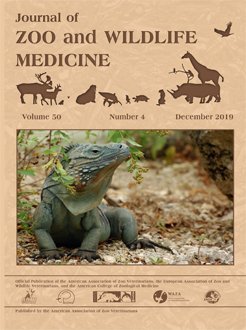Abnormal molting, including partial or incomplete molt, arrested molt cycle, or inappropriate frequency of molt, is a primary concern for the managed African penguin (Spheniscus demersus) population and is documented across institutions. To identify factors associated with increased odds of abnormal molts and characterize intervention opportunities, a comprehensive survey evaluating numerous husbandry and medical parameters was created. Survey results represent 45 North American African penguin holding facilities and 736 unique animals. Of these individuals, 135 (18.3%) demonstrated an abnormal molt over the 5-yr study period (2012–2017). Increased odds ratios for abnormal molt included biologic (age, sex, etc.), geographic (elevation, latitude), and husbandry (exhibit design, diet, etc.) variables. The mean age of affected animals was 15.2 yr (1–45 yr, n = 135) compared with 9.92 yr (4 mo–38 yr, n = 601) for unaffected animals. In addition, although statistically insignificant, males were overrepresented in the affected cohort compared with a near even distribution among unaffected animals. Identified factors with increased odds for abnormal molting included advanced age and facilities using freshwater pools. Normally molting penguins were more commonly found with saltwater pool access and natural lighting exposure. Anecdotal medical intervention attempts are discussed, although further research is needed to define their use. Of attempted interventions, subcutaneous 5.4-mg melatonin implants placed in anticipation of environmental molting cues showed the most promise at inducing catastrophic molt, with 14 of 17 (82.3%) of affected individuals molting normally following this treatment. Survey analysis indicated that abnormal molt is a complex, multifactorial process, and modifiable factors that may predispose animals to abnormally molt exist. Addressing these factors in future exhibit design may mitigate the prevalence of this condition. Despite these efforts, it is likely that medical interventions will be required to aid in the treatment of abnormal molting in this species.
How to translate text using browser tools
9 January 2020
FACTORS AFFECTING ABNORMAL MOLTING IN THE MANAGED AFRICAN PENGUIN (SPHENISCUS DEMERSUS) POPULATION IN NORTH AMERICA
Matthew Golembeski,
Samantha J. Sander,
Jennifer Kottyan,
William E. Sander,
Ellen Bronson
ACCESS THE FULL ARTICLE
African penguin
feathers
husbandry
Melatonin
molting
Spheniscus demersus





